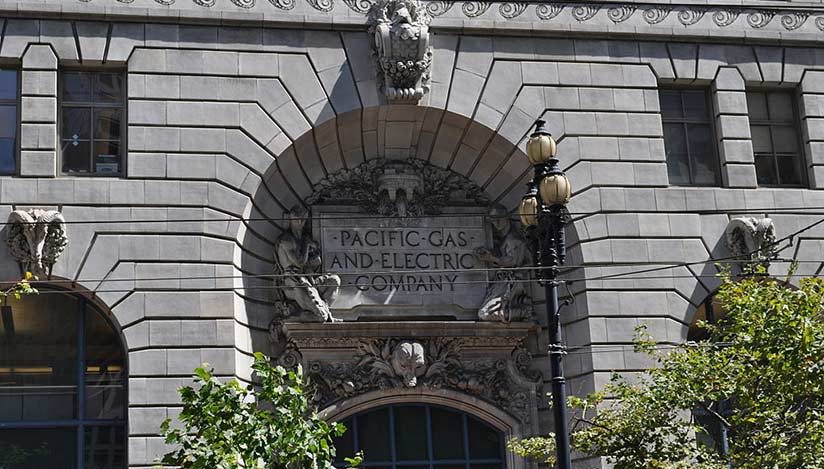How PG&E’s Bankruptcy Will Impact Solar Customers
On January 14th, 2019, Pacific Gas & Electric announced that it would file Chapter 11 bankruptcy. This action does not mean that the company will stop supplying electricity or be dissolved. Instead, filing for bankruptcy allows them to restructure their debts and shed some of their financial obligations.
This is an extremely significant decision, reflecting the precarious situation that the company is in. PG&E is a publicly traded company, and has long been a very stable and successful one. Between 2009 and early November of 2018, PG&E’s stock traded between $38 and $68. But in the weeks following the devastating Camp Fire, the company’s stock price dropped from $47 to a low of less than $6.50.
As of late January 2019, PG&E’s stock is priced at $12, and the company as a whole is valued at about $6.25 billion. PG&E estimates that the financial damages it will ultimately face for its role in the fires of 2017 and 2018 will amount to at least $30 billion, five times the company’s current worth.
This is why PG&E has filed bankruptcy—to slow down and consolidate the many lawsuits filed against it, and to raise money by selling off assets. But this is going to be a very touch and go period for PG&E, its investors, and the five and a half million people and businesses that purchase electricity from the company. The company’s attempt to save itself may ultimately fail, with Chapter 11 bankruptcy becoming Chapter 7 bankruptcy. In this scenario, we would likely be looking at the state of California taking over the company’s massive operations—an option which the state has been considering since December of 2018.
But in the meantime, how will PG&E’s Chapter 11 bankruptcy filing impact its customers, particularly those who have solar power? The bankruptcy process is slow. When PG&E filed for bankruptcy in 2001, it took the company three years to complete the process. As this bankruptcy plays out, assuming there are no significant changes—such as California stepping in and taking the company over—here’s what you can expect as a PG&E customer.
Don’t worry, PG&E isn’t suddenly going to turn your power off.
As a regulated utility, PG&E can’t pull the plug on you in order to cut their costs. They are required to continue to provide electricity and natural gas services to their customers. So, you shouldn’t expect to suddenly start experiencing rolling blackouts or any other interruptions of service, as occurred during the Enron-instigated crisis of 2000 and 2001.
However, your energy rates might go up.
In December 2018, PG&E asked state regulators to approve rate increases for 2020 they estimate would increase the average customer’s bill by 6.4%, compared to 2019. However, in their rate increase proposal, they actually request that their allowed revenue be increased from $8.506 billion in 2019 to $9.6 billion, an increase of nearly $1.1 billion which would amount to a 12.9% increase. Clearly, some customers would be hit harder than others. PG&E also requested additional revenue increases of $454 million in 2021 and $486 million in 2022. The would amount to an increase of 23.9% from 2019 to 2022.
In addition, PG&E is pursuing another $1.2 billion in rate increases between 2020 and 2022 to cover the cost of decommissioning and associated remediation of the Diablo Canyon Power Plant and Humboldt Bay Power Plant Unit 3. In addition, under a bill signed into law in September 2018, PG&E will be able to pass on the anticipated costs of future legal settlements to customers.
Historically, PG&E’s rates have increased by an average of 7.1% year-over-year since 2009. With the company’s financials in dire straits, and given the above, it appears safe to assume that PG&E’s rate increases will exceed that average for much of the next several years.
Net energy metering (NEM) likely won’t be impacted at all.
Under California’s net energy metering program, customers who generate excess electricity and send it to the grid are given a credit by PG&E—essentially, the company buys electricity from homeowners. While PG&E may be struggling financially, it is obligated by state law to cooperate in the NEM program.
Thus, homeowners should expect that they will continue to be compensated fairly for the electricity they generate, both in terms of NEM credits and net surplus compensation (NSC). The same is true of businesses and organizations that participate in the Self-Generation Incentive Program (SGIP).
New solar power users could see delays in being connected to the grid.
Many observers believe that one of the key consequences of PG&E’s financial woes will be layoffs . Reduced staffing may result in delays with processing interconnection requests, which means estimates for when your new solar power system can go live may prove to be optimistic by a few weeks.
So, the takeaway for PG&E customers with solar power systems is that your service won’t be interrupted. You’ll continue to be compensated for the energy you produce, as per the company’s legal obligations. However, your electricity bills will likely increase—possibly more so than they have in the past—and new solar adopters may see delays of days or weeks in having their systems activated if PG&E opts to lay off employees down the line.
If PG&E’s circumstances change significantly in a manner that will impact customers, we’ll keep you updated. In the meantime, if you have any questions, such as whether it makes sense to purchase a solar power system right now, please feel free to contact us!
*Image credit: Joe Mabel (Licensing: CC-BY-3.0)

